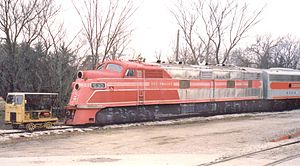EMD E6
EMD E6

|
|
|
|
|
| Performance figures |
| Power output |
2,000 hp (1,500 kW) total |
|
| Career |
| Disposition |
Two preserved, remainder scrapped |
|
| Performance figures |
| Power output |
2,000 hp (1,500 kW) total |
| Career |
| Disposition |
Two preserved, remainder scrapped |
The EMD E6 was a 2,000-horsepower (1,500 kW), A1A-A1A, passenger train locomotive manufactured by Electro-Motive Corporation, and its corporate successor, General Motors Electro-Motive Division, of La Grange, Illinois. The cab version, E6A, was manufactured from November 1939 to September 1942; 91 were produced. The booster version, E6B, was manufactured from April 1940 to February 1942; 26 were produced. The 2,000-horsepower (1,500 kW) was achieved by putting two 1,000-horsepower (750 kW), 12-cylinder, model 567 engines in the engine compartment. Each engine drove its own electrical generator to power the traction motors. The E6 was the seventh model in a long line of passenger diesels of similar design known as EMD E-units.
Compared with passenger locomotives made later by EMD, the noses of the E3, E4, E5,and E6 cab units had pronounced slants when viewed from the side. Therefore, these four models have been nicknamed "slant nose" units. Later E models had the "bulldog nose" of the F series.
One interesting E6 variant custom-produced for the Missouri Pacific was the model EMC AA. This was a motorcar-style unit which had only one prime mover and 1,000 horsepower (750 kW), and substituted a baggage compartment where the other diesel V-12 would have been. The Chicago, Rock Island and Pacific owned an equally interesting pair of similar power cars known as the EMC AB6, which were mechanically identical but had boxcabs in blunt noses. These acted as boosters behind conventional E6A models on the Rocky Mountain Rocket train between Chicago and Limon, Colorado, from where the E6A would take the Denver cars north and the AB6 would take the Colorado Springs section of the train south.
...
Wikipedia

